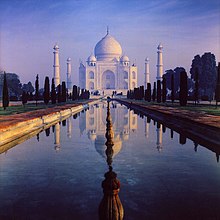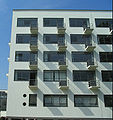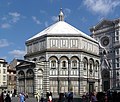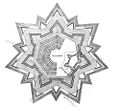Mathematics and architecture

Mathematics and architecture are related, since,
In
In Renaissance architecture, symmetry and proportion were deliberately emphasized by architects such as Leon Battista Alberti, Sebastiano Serlio and Andrea Palladio, influenced by Vitruvius's De architectura from ancient Rome and the arithmetic of the Pythagoreans from ancient Greece. At the end of the nineteenth century,
Connected fields

The architects Michael Ostwald and
Williams and Ostwald, further overviewing the interaction of mathematics and architecture since 1500 according to the approach of the German sociologist
Architects use mathematics for several reasons, leaving aside the necessary use of mathematics in the engineering of buildings.[5] Firstly, they use geometry because it defines the spatial form of a building.[6] Secondly, they use mathematics to design forms that are
Secular aesthetics
Ancient Rome

Vitruvius
The influential ancient Roman architect Vitruvius argued that the design of a building such as a temple depends on two qualities, proportion and symmetria. Proportion ensures that each part of a building relates harmoniously to every other part. Symmetria in Vitruvius's usage means something closer to the English term modularity than mirror symmetry, as again it relates to the assembling of (modular) parts into the whole building. In his Basilica at Fano, he uses ratios of small integers, especially the triangular numbers (1, 3, 6, 10, ...) to proportion the structure into (Vitruvian) modules.[a] Thus the Basilica's width to length is 1:2; the aisle around it is as high as it is wide, 1:1; the columns are five feet thick and fifty feet high, 1:10.[9]

Vitruvius named three qualities required of architecture in his De architectura, c. 15 B.C.: firmness, usefulness (or "Commodity" in Henry Wotton's 16th century English), and delight. These can be used as categories for classifying the ways in which mathematics is used in architecture. Firmness encompasses the use of mathematics to ensure a building stands up, hence the mathematical tools used in design and to support construction, for instance to ensure stability and to model performance. Usefulness derives in part from the effective application of mathematics, reasoning about and analysing the spatial and other relationships in a design. Delight is an attribute of the resulting building, resulting from the embodying of mathematical relationships in the building; it includes aesthetic, sensual and intellectual qualities.[16]
The Pantheon
The
Renaissance

The first Renaissance treatise on architecture was Leon Battista Alberti's 1450

The next major text was Sebastiano Serlio's Regole generali d'architettura (General Rules of Architecture); the first volume appeared in Venice in 1537; the 1545 volume (books 1 and 2) covered geometry and perspective. Two of Serlio's methods for constructing perspectives were wrong, but this did not stop his work being widely used.[23]
In 1570, Andrea Palladio published the influential I quattro libri dell'architettura (The Four Books of Architecture) in Venice. This widely printed book was largely responsible for spreading the ideas of the Italian Renaissance throughout Europe, assisted by proponents like the English diplomat Henry Wotton with his 1624 The Elements of Architecture.[24] The proportions of each room within the villa were calculated on simple mathematical ratios like 3:4 and 4:5, and the different rooms within the house were interrelated by these ratios. Earlier architects had used these formulas for balancing a single symmetrical facade; however, Palladio's designs related to the whole, usually square, villa.[25] Palladio permitted a range of ratios in the Quattro libri, stating:[26][27]
There are seven types of room that are the most beautiful and well proportioned and turn out better: they can be made circular, though these are rare; or square; or their length will equal the diagonal of the square of the breadth; or a square and a third; or a square and a half; or a square and two-thirds; or two squares.[c]
In 1615, Vincenzo Scamozzi published the late Renaissance treatise L'idea dell'architettura universale (The Idea of a Universal Architecture).[28] He attempted to relate the design of cities and buildings to the ideas of Vitruvius and the Pythagoreans, and to the more recent ideas of Palladio.[29]
Nineteenth century

Hyperboloid structures were used starting towards the end of the nineteenth century by Vladimir Shukhov for masts, lighthouses and cooling towers. Their striking shape is both aesthetically interesting and strong, using structural materials economically. Shukhov's first hyperboloidal tower was exhibited in Nizhny Novgorod in 1896.[30][31][32]
Twentieth century

The early twentieth century movement Modern architecture, pioneered[d] by Russian Constructivism,[33] used rectilinear Euclidean (also called Cartesian) geometry. In the De Stijl movement, the horizontal and the vertical were seen as constituting the universal. The architectural form consists of putting these two directional tendencies together, using roof planes, wall planes and balconies, which either slide past or intersect each other, as in the 1924 Rietveld Schröder House by Gerrit Rietveld.[34]
Modernist architects were free to make use of curves as well as planes. Charles Holden's 1933 Arnos station has a circular ticket hall in brick with a flat concrete roof.[35] In 1938, the Bauhaus painter László Moholy-Nagy adopted Raoul Heinrich Francé's seven biotechnical elements, namely the crystal, the sphere, the cone, the plane, the (cuboidal) strip, the (cylindrical) rod, and the spiral, as the supposed basic building blocks of architecture inspired by nature.[36][37]
Contemporary architecture, in the opinion of the 90 leading architects who responded to a 2010 World Architecture Survey, is extremely diverse; the best was judged to be Frank Gehry's Guggenheim Museum, Bilbao.[42]
Denver International Airport's terminal building, completed in 1995, has a
The architect
Sydney Opera House has a dramatic roof consisting of soaring white vaults, reminiscent of ship's sails; to make them possible to construct using standardized components, the vaults are all composed of triangular sections of spherical shells with the same radius. These have the required uniform curvature in every direction.[46]
The late twentieth century movement
-
Cylinder: Charles Holden's Arnos Grove tube station, 1933
-
Chapelle Notre Dame du Haut, 1955
-
R. Buckminster Fuller, 1967
-
Uniform curvature: Sydney Opera House, 1973
-
Disney Concert Hall, Los Angeles, 2003
Religious principles
Ancient Egypt

The
The proportions of some pyramids may have also been based on the
Ancient India
The mathematics of
The ideal form gracefully artificed suggests the infinite rising levels of existence and consciousness, expanding sizes rising toward transcendence above, and at the same time housing the sacred deep within.[59][60]
The
Ancient Greece

Pythagoras (c. 569 – c. 475 B.C.) and his followers, the Pythagoreans, held that "all things are numbers". They observed the harmonies produced by notes with specific small-integer ratios of frequency, and argued that buildings too should be designed with such ratios. The Greek word symmetria originally denoted the harmony of architectural shapes in precise ratios from a building's smallest details right up to its entire design.[12]
The Parthenon is 69.5 metres (228 ft) long, 30.9 metres (101 ft) wide and 13.7 metres (45 ft) high to the cornice. This gives a ratio of width to length of 4:9, and the same for height to width. Putting these together gives height:width:length of 16:36:81, or to the delight[62] of the Pythagoreans 42:62:92. This sets the module as 0.858 m. A 4:9 rectangle can be constructed as three contiguous rectangles with sides in the ratio 3:4. Each half-rectangle is then a convenient 3:4:5 right triangle, enabling the angles and sides to be checked with a suitably knotted rope. The inner area (naos) similarly has 4:9 proportions (21.44 metres (70.3 ft) wide by 48.3 m long); the ratio between the diameter of the outer columns, 1.905 metres (6.25 ft), and the spacing of their centres, 4.293 metres (14.08 ft), is also 4:9.[12]

The Parthenon is considered by authors such as
The golden ratio was known in 300 B.C., when Euclid described the method of geometric construction.[66] It has been argued that the golden ratio was used in the design of the Parthenon and other ancient Greek buildings, as well as sculptures, paintings, and vases.[67] More recent authors such as Nikos Salingaros, however, doubt all these claims.[68] Experiments by the computer scientist George Markowsky failed to find any preference for the golden rectangle.[69]
Islamic architecture

The historian of Islamic art Antonio Fernandez-Puertas suggests that the
The Selimiye Mosque in Edirne, Turkey, was built by Mimar Sinan to provide a space where the mihrab could be seen from anywhere inside the building. The very large central space is accordingly arranged as an octagon, formed by eight enormous pillars, and capped by a circular dome of 31.25 metres (102.5 ft) diameter and 43 metres (141 ft) high. The octagon is formed into a square with four semidomes, and externally by four exceptionally tall minarets, 83 metres (272 ft) tall. The building's plan is thus a circle, inside an octagon, inside a square.[73]
Mughal architecture

Mughal architecture, as seen in the abandoned imperial city of Fatehpur Sikri and the Taj Mahal complex, has a distinctive mathematical order and a strong aesthetic based on symmetry and harmony.[11][74]
The Taj Mahal exemplifies Mughal architecture, both representing

The Taj Mahal complex was laid out on a grid, subdivided into smaller grids. The historians of architecture Koch and Barraud agree with the traditional accounts that give the width of the complex as 374 Mughal yards or
Christian architecture
The
a) Plan of gallery (upper half)
b) Plan of the ground floor (lower half)
The importance of water
The number five is used "exuberantly"
Antoni Gaudí used a wide variety of geometric structures, some being minimal surfaces, in the Sagrada Família, Barcelona, started in 1882 (and not completed as of 2023). These include hyperbolic paraboloids and hyperboloids of revolution,[90] tessellations, catenary arches, catenoids, helicoids, and ruled surfaces. This varied mix of geometries is creatively combined in different ways around the church. For example, in the Passion Façade of Sagrada Família, Gaudí assembled stone "branches" in the form of hyperbolic paraboloids, which overlap at their tops (directrices) without, therefore, meeting at a point. In contrast, in the colonnade there are hyperbolic paraboloidal surfaces that smoothly join other structures to form unbounded surfaces. Further, Gaudí exploits natural patterns, themselves mathematical, with columns derived from the shapes of trees, and lintels made from unmodified basalt naturally cracked (by cooling from molten rock) into hexagonal columns.[91][92][90]
The 1971
Several medieval churches in Scandinavia are circular, including four on the Danish island of Bornholm. One of the oldest of these, Østerlars Church from c. 1160, has a circular nave around a massive circular stone column, pierced with arches and decorated with a fresco. The circular structure has three storeys and was apparently fortified, the top storey having served for defence.[98] [99]
-
The vaulting of the nave ofHaghia Sophia, Istanbul (annotations), 562
-
The octagonal Baptistry of Saint John, Florence, completed in 1128
-
Fivefold symmetries:Pilgrimage Church of St John of Nepomukat Zelená hora, 1721
-
Oscar Niemeyer's Cathedral of Brasília, 1970
-
TheCathedral of Saint Mary of the Assumption, San Francisco, 1971
-
Central column ofNordic round church in Bornholm, Denmark
Mathematical decoration
Islamic architectural decoration
Islamic buildings are often decorated with
-
The complex geometry and tilings of the muqarnas vaulting in the Sheikh Lotfollah Mosque, Isfahan, 1603–1619
-
Louvre Abu Dhabi under construction in 2015, its dome built up of layers of stars made of octagons, triangles, and squares
Modern architectural decoration
Towards the end of the 20th century, novel mathematical constructs such as fractal geometry and aperiodic tiling were seized upon by architects to provide interesting and attractive coverings for buildings.
-
Ravensbourne College, London, 2010
-
Harpa Concert and Conference Centre, Iceland, 2011
-
Kanazawa Umimirai Library, Japan, 2011
-
Museo Soumaya, México, 2011
Defence
Europe
The architecture of
The architectural historian
-
Coevorden fortification plan. 17th century
-
star fort. 17th century
-
Fortifications of Vauban
China
In
Environmental goals
Architects may also select the form of a building to meet environmental goals.
The traditional
See also
- Black Rock City
- Mathematics and art
- Patterns in nature
Notes
- ^ In Book 4, chapter 3 of De architectura, he discusses modules directly.[15]
- Roman footwas about 0.296 metres (0.97 ft).
- ^ In modern algebraic notation, these ratios are respectively 1:1, √2:1, 4:3, 3:2, 5:3, 2:1.
- ^ Constructivism influenced Bauhaus and Le Corbusier, for example.[33]
- ^ Pace Nikos Salingaros, who suggests the contrary,[39] but it is not clear exactly what mathematics may be embodied in the curves of Le Corbusier's chapel.[40]
- ^ Berlin Papyrus 6619 from the Middle Kingdom stated that "the area of a square of 100 is equal to that of two smaller squares. The side of one is ½ + ¼ the side of the other."
- ^ 1 gaz is about 0.86 metres (2.8 ft).
- ^ A square drawn around the octagon by prolonging alternate sides adds four right angle triangles with hypotenuse of 7 and the other two sides of √49/2 or 4.9497..., nearly 5. The side of the square is thus 5+7+5, which is 17.
- ^ Until Seville Cathedral was completed in 1520.
- ^ The sixth day of Holy Week was Good Friday; the following Sunday (of the resurrection) was thus the eighth day.[83]
- ^ This is 90 tonnes (89 long tons; 99 short tons).
- ^ An aperiodic tiling was considered, to avoid the rhythm of a structural grid, but in practice a Penrose tiling was too complex, so a grid of 2.625m horizontally and 4.55m vertically was chosen.[103]
References
- ^ a b c Freiberger, Marianne (1 March 2007). "Perfect buildings: the maths of modern architecture". Plus magazine. Retrieved 5 October 2015.
- ^ .
- ISBN 978-3-319-00136-4.
- ^ ISBN 978-3-319-00142-5.
- ^ "Architectural Engineering Overview" (PDF). Sloan Career Cornerstone Center. Archived from the original (PDF) on 14 July 2015. Retrieved 11 October 2015.
- ISBN 978-3-540-42717-9.
- ISBN 978-981-277-582-5.
- ^ Smith, William (1870). Dictionary of Greek and Roman Biography and Mythology. Little, Brown. p. 620.
- ^ ISBN 978-0-14-193195-1.
- ^ a b Tennant, Raymond (July 2003). "International Joint Conference of ISAMA, the International Society of the Arts, Mathematics, and Architecture, and BRIDGES. Mathematical Connections in Art Music, and Science, University of Granada, Spain, July, 2003. Islamic Constructions: The Geometry Needed by Craftsmen" (PDF). International Joint Conference of ISAMA, the International Society of the Arts, Mathematics, and Architecture, and BRIDGES, Mathematical Connections in Art Music, and Science.
- ^ a b Rai, Jaswant (1993). "Mathematics and Aesthetics in Islamic Architecture: Reference to Fatehpur Sikri" (PDF). Journal of King Saud University, Architecture & Planning. 5 (1): 19–48.
- ^ a b c d e f g O'Connor, J. J.; Robertson, E. F. (February 2002). "Mathematics and Architecture". University of St Andrews. Retrieved 4 October 2015.
- ^ van den Hoeven, Saskia; van der Veen, Maartje (2010). "Muqarnas: Mathematics in Islamic Arts" (PDF). Utrecht University. Archived from the original (PDF) on 4 March 2016. Retrieved 30 September 2015.
- ISBN 978-0-521-72876-8.
- ^ Vitruvius. "VITRUVIUS, BOOK IV, CHAPTER 3 On the Doric order". Vitruvius.be. Retrieved 6 October 2015.
- ISBN 978-3-319-00137-1.
- ISBN 0-06-438493-4.
- ISBN 0-19-288003-9.
- ISBN 0-521-84202-6.
- S2CID 110346888.
- ^ "Sphere circumscribing a cube". Mathalino.com Engineering Math Review. Retrieved 4 October 2015.
- ^ Typ 525.69.781, Houghton Library, Harvard University
- ISBN 978-0-387-48946-9.
- ^ Ruhl, Carsten (7 April 2011). "Palladianism: From the Italian Villa to International Architecture". European History Online. Retrieved 3 October 2015.
- ISBN 9780600039549.
- ^ Wassell, Stephen R. "The Mathematics Of Palladio's Villas: Workshop '98". Nexus Network Journal. Retrieved 3 October 2015.
- ^ Palladio, Andrea; Tavernor, Robert; Schofield, Richard (trans.) (1997) [1570]. I quattro libri dell'architettura. MIT Press. p. book I, chapter xxi, page 57.
{{cite book}}: CS1 maint: multiple names: authors list (link) - ^ Scamozzi, Vincenzo; Vroom, W. H. M. (trans.) (2003) [1615]. The Idea of a Universal Architecture. Architectura & Natura.
- ISBN 978-1-4094-5580-6.
- ISBN 978-1-118-93268-1.
- ^ "The Nijni-Novgorod exhibition: Water tower, room under construction, springing of 91 feet span". The Engineer: 292–294. 19 March 1897.
- ISBN 3-421-02984-9.
- ^ a b Hatherley, Owen (4 November 2011). "The Constructivists and the Russian Revolution in Art and Architecture". The Guardian. Retrieved 6 June 2016.
- ^ "Rietveld Schröderhuis (Rietveld Schröder House)". World Heritage Centre. UNESCO. Retrieved 13 December 2012.
- ^ Historic England. "Details from listed building database (1358981)". National Heritage List for England. Retrieved 5 October 2015.
- ^ Moholy-Nagy, Laszlo; Hoffman, Daphne M. (trans.) (1938). The New Vision: Fundamentals of Design, Painting, Sculpture, Architecture. New Bauhaus Books. p. 46.
- ISBN 978-0-691-16528-8.
- ISBN 3-7643-6188-3.
- ^ S2CID 120544101.
- ^ Greene, Herb. "Le Corbusier: Notre Dame du Haut at Ronchamp". Archived from the original on 7 September 2015. Retrieved 5 October 2015.
- ISBN 978-0-313-31902-0.
- ^ "Vanity Fair's World Architecture Survey: the Complete Results". Vanity Fair. 30 June 2010. Archived from the original on 8 November 2014. Retrieved 22 July 2010.
- ^ "Denver International Airport Press Kit" (PDF). Denver International Airport. 2014. Archived from the original (PDF) on 12 April 2015. Retrieved 5 October 2015.
- ^ "Denver International Airport". Fenstress Architects. Retrieved 5 October 2015.
- ^ "Biosphere". A view on cities. Archived from the original on 27 September 2007. Retrieved 1 October 2015.
- ^ Hahn, Alexander J. (4 February 2013). "Mathematical Excursions To Architecture". Inside Science. Retrieved 5 October 2015.
- ISBN 9783937954073.
- ISBN 9783937954073.
- ISBN 9780979472749.
- ISBN 9781890449285.
- ^ .
- doi:10.1080/07468342.1992.11973428. Archived from the original(PDF) on 8 April 2008. Retrieved 1 October 2015.
- ISBN 0-7679-0816-3.
- ^ ISBN 978-1-118-03024-0.
- ^ Gillings, Richard J. (1982). Mathematics in the Time of the Pharaohs. Dover. p. 161.
- ISBN 81-208-0223-3
- ISBN 978-1-86189-137-2.
- ^ Ifrah, Georges (1998). A Universal History of Numbers. Penguin.
- ^ a b "Fractals in Indian Architecture". Yale University. Archived from the original on 6 February 2012. Retrieved 1 October 2015.
- ^ Jackson, William J. "For All Fractal Purposes ... an introduction". Indiana University-Purdue University Indianapolis. Archived from the original on 14 September 2015. Retrieved 1 October 2015.
- ISBN 0-203-48075-9.
- ISBN 978-0-691-12526-8.
- ^ a b Norwich, John Julius (2001). Great Architecture of the World. Artists House. p. 63.
- ^ Penrose, Francis (1973) [1851]. Principles of Athenian Architecture. Society of Dilettanti. p. ch. II.3, plate 9.
- S2CID 192963601.
- ^ Euclid. Elements. Book 6, Proposition 30.
- ^ Archibald, R. C. "Notes on the Logarithmic Spiral, Golden Section and the Fibonacci Series". Retrieved 1 October 2015.
- ^ Salingaros, Nikos (22 February 2012). "Applications of the Golden Mean to Architecture".
- doi:10.1080/07468342.1992.11973428. Archived from the original(PDF) on 8 April 2008. Retrieved 1 October 2015.
- ^ Gedal, Najib. "The Great Mosque of Cordoba: Geometric Analysis". Islamic Art & Architecture. Archived from the original on 2 October 2015. Retrieved 16 October 2015.
- ISBN 978-1-84765-098-6.
- ^ Robertson, Ann (2007). "Revisiting the Geometry of the Sala de Dos Hermanas" (PDF). BRIDGES. Retrieved 11 October 2015.
- ISBN 0-300-06465-9.
- ISBN 978-1-85149-670-9.
- ISBN 978-1-4053-4124-0.
- ISBN 0-500-34209-1.
- ISBN 0-500-34209-1.
- ISBN 978-0-07-305304-2.
- ISBN 978-0-691-16528-8.
- ISBN 978-0-495-46740-3.
- ^ Menander, Hanna; Brandt, Olof; Appetechia, Agostina; Thorén, Håkan (2010). "The Lateran Baptistery in Three Dimensions" (PDF). Swedish National Heritage Board. Retrieved 30 October 2015.
- ^ "The Baptistery". The Leaning Tower of Pisa. Retrieved 30 October 2015.
- ^ a b Huyser-Konig, Joan. "Theological Reasons for Baptistry Shapes". Calvin Institute of Christian Worship. Retrieved 30 October 2015.
- ^ ISBN 978-0-929650-00-5.
- The City of God. p. Book 22, Chapter 30.
- ISBN 978-1-133-71116-2.
- ^ ISBN 978-1-62788-048-0.
- ^ "Zelená hora near Žďár nad Sázavou". Czech Tourism. Retrieved 10 November 2015.
- ^ "Attributes of Saint John of Nepomuk". Saint John of Nepomuk. Archived from the original on 4 March 2016. Retrieved 10 November 2015.
- ^ a b M.C. Burry; J.R. Burry; G.M. Dunlop; A. Maher (2001). "Drawing Together Euclidean and Topological Threads" (PDF). The 13th Annual Colloquium of the Spatial Information Research Centr. University of Otago, Dunedin, New Zealand. Archived from the original (PDF) on 25 June 2008. Retrieved 5 August 2008.
- ^ "The Geometry of Antoni Gaudi". Math & the Art of MC Escher. Saint Louis University Mathematics and Computer Science. Retrieved 4 October 2015.
- ^ Usvat, Liliana. "Antony Gaudi and Mathematics". Mathematics Magazine. Retrieved 4 October 2015.
- ^ Nervi, Pier Luigi. "Cathedral of Saint Mary of the Assumption". Architectuul. Retrieved 12 October 2015.
- ^ "Brasilia Cathedral". About Brasilia. Retrieved 13 November 2015.
- ISBN 978-3-642-25710-0.
- ISBN 978-88-470-2427-4.
- ^ Mkrtchyan, Ruzanna (2013). "Cathedral of Brasilia". Building.AM. Retrieved 13 November 2015.
- ^ "Østerlars kirke" (in Danish). Nordens kirker. Retrieved 2 December 2016.
- ^ "Østerlars kirke" (in Danish). Natur Bornholm. Archived from the original on 19 July 2011. Retrieved 2 December 2016.
- ^ a b Rønning, Frode. "Islamic Patterns And Symmetry Groups" (PDF). University of Exeter. Retrieved 18 April 2014.
- ^ a b c Gibberd, Matt; Hill, Albert (20 August 2013). "The Return of Ornamentation". The Telegraph. Archived from the original on 18 October 2014. Retrieved 12 October 2015.
- ^ "Ravensbourne College by Foreign Office Architects". de zeen magazine. 13 September 2010. Retrieved 12 October 2015.
- ^ a b Bizley, Graham. "FOA's peninsula patterns for Ravensbourne College". bdonline.co.uk. Retrieved 16 October 2015.
- ISBN 978-0-7858-2109-0.
- ISBN 978-0-946771-42-4.
- Giedion, Siegfried(1962) [1941]. Space, Time and Architecture. Harvard University Press. p. 43.
- National Geographic. Archived from the originalon 2 January 2015. Retrieved 6 January 2017.
- ^ Ayre, James (28 April 2018). "Yakhchāls, Āb Anbārs, & Wind Catchers — Passive Cooling & Refrigeration Technologies Of Greater Iran (Persia)". CleanTechnica. Archived from the original on 1 May 2018. Retrieved 25 February 2022.
External links
- Nexus Network Journal: Architecture and Mathematics Online
- The International Society of the Arts, Mathematics, and Architecture
- University of St Andrews: Mathematics and Architecture
- National University of Singapore: Mathematics in Art and Architecture
- Dartmouth College: Geometry in Art & Architecture























